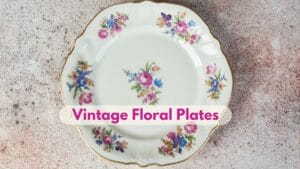Do you think your modern dinnerware is impressive? Wait until you see what people were eating off 100+ years ago! This exclusive list showcases 30+ super rare antique dishes that will make you question why we ever stopped making things this beautiful!

From hand-painted plates to intricate glass pieces in distinctive shapes, these vintage dishes prove our ancestors knew how to dine in style. Let’s take a look at the perfect examples of antique craftsmanship that put today’s mass-produced plates to shame!
1. Fra Xanto Avelli Dish with Woman of Sestos and Pucci Arms

- Manufacturing Date: ca. 1532
- Period: Renaissance, 16th Century
- Origin: Urbino, Italy
- Maker/Artist: Fra Xanto Avelli da Rovigo
- Material: Maiolica (tin-glazed earthenware)
- Pattern: Classical Scene with Heraldic Arms
This ancient plate displays an entire story! Fra Xanto painted this touching story about a loyal eagle who chose to die with the girl who raised him. What’s clever is how he used the dish’s curved shape to make the scene look three-dimensional, with people on the rim watching the drama unfold in the center.
The Pucci family coat of arms tells us this was expensive custom work. There’s even an inscription on the back crediting the Roman writer Pliny as the source! Getting to see such a historical piece is a sign of luck today!
2. Chinese Export Saucer (for Dutch Market)

- Manufacturing Date: 1750–70
- Period: 18th century
- Origin: China (possibly for the Dutch market)
- Maker/Artist: Unknown Chinese manufacturer
- Material: Porcelain
- Pattern: Export Decoration Suited to Dutch Tastes
This saucer shows how connected the world was even back then. Chinese potters made it specifically for Dutch customers. The plate shows a portrait of a lady sewing a piece of fabric, with intricate, life-like features. This extremely rare 250-year-old plate stands against modern, simple designs, making it a museum piece!
3. Meissen Böttger-Type Saucer

- Manufacturing Date: 1725–30
- Period: Early 18th century
- Origin: Meissen, Germany
- Maker/Artist: Meissen Manufactory
- Material: Böttger-type Porcelain
- Pattern: Romantic Landscape Scenes
This saucer comes from a mixed-and-matched set where different artists painted various scenes – garden pavilions, river views, winter skating scenes. It’s made from that early Böttger porcelain when Meissen was still perfecting their recipe.
The extraordinarily detailed romantic landscape is an example of craftsmanship shifts in the 1720s, which are hardly seen in today’s dishes!
4. Walls and Hanging Gardens of Babylon Victorian Dish

- Manufacturing Date: 1898
- Period: Victorian Era, Mid-19th century
- Origin: Britain
- Maker/Artist: Unknown British Manufacturer
- Material: Porcelain
- Pattern: Hanging Gardens of Babylon Scene
The Victorians went crazy for ancient Mesopotamia after archaeologists started digging up Assyrian palaces. This dish shows the legendary Hanging Gardens of Babylon, copied from John Martin’s famous painting.
Here’s the funny thing – Martin painted his version in 1819 before anyone had actually excavated much, so he just mixed together Roman, Egyptian, and Indian architecture to guess what Babylon looked like. The dish turns his dramatic, apocalyptic scene into something more peaceful.
5. Japanese Nabeshima Dish with Three Jars

- Manufacturing Date: 1680–90s
- Period: Edo period (1615–1868)
- Origin: Hizen region, Kyūshū, Japan
- Maker/Artist: Nabeshima kiln
- Material: Porcelain
- Pattern: Three Decorative Jars Design
This happy little dish shows three painted jars in those bright, perfect colors that made Nabeshima porcelain famous. The Nabeshima clan had their own exclusive kiln that made pieces so good they regularly sent them as gifts to the shogun in Tokyo.
That’s basically like having your pottery chosen as the official presidential gift – it was seriously high-quality stuff that represented the best Japanese ceramic work of the time.
6. Blue and White Qing Dynasty Dish

- Manufacturing Date: Unknown
- Period: Qing dynasty (1644–1911)
- Origin: China
- Maker/Artist: Unknown Chinese potter
- Material: Porcelain Painted in Underglaze Blue
- Pattern: Women and Flowers in Blue and White
This dish is an exotic example of the iconic blue and white China! It’s a 5-inch saucer that shows women surrounded by flowers, painted in that classic cobalt blue that made Chinese ceramics famous worldwide.
The underglaze technique means the blue was painted directly onto the porcelain before glazing, creating those deep, rich colors that have lasted for centuries. It’s the kind of piece that could fit perfectly in a Qing dynasty palace or a modern kitchen, but isn’t made today!
7. Square Dish with Landscape and Poem

- Artist: Kiyomizu Rokubei V (Japanese)
- Painted by: Hashimoto Dokuzan (Japanese)
- Manufacturing Date/Period: 1929
- Period: Shōwa period (1926–89)
- Style: Chinese-style vessel representing Kyoto literati taste
This dish came about through an interesting collaboration between two artists with very different backgrounds. Kiyomizu Rokubei V knew ceramics inside and out. He teamed up with Hashimoto Dokuzan, a skilled Zen Buddhist painter.
Together, they created this unique dish that captures the refined taste of Kyoto’s intellectual circles, blending Japanese ceramic skills with Chinese artistic influences.
8. Chelsea Botanical Plate with Flowering Eggplant

- Manufacturing Date: ca. 1755
- Period: Mid-18th century
- Origin: Chelsea, England
- Maker/Artist: Chelsea Porcelain Manufactory
- Material: Porcelain
- Pattern: Hand-painted Flowering Eggplant
This plate is part of the famous Chelsea “Hans Sloane” botanical series that brought scientific illustration to the dinner table. The hand-painted flowering eggplant was copied from botanical illustrations by Philip Miller, curator of the Chelsea Physic Garden.
The realistic painting style captures not just the plant’s appearance but its scientific importance, making it an extraordinary collectible piece for wealthy collectors. These plates reflect the Enlightenment’s fascination with cataloging and taking influence from the natural world.
9. Display Dish with Charles II on a Tree

- Manufacturing Date: ca. 1680
- Period: Late 17th century
- Origin: North Staffordshire, Britain
- Maker/Artist: Thomas Toft
- Material: Earthenware with slip decoration
- Pattern: King Charles II in Oak Tree with Lion and Unicorn
This 345-year-old dish captures one of history’s great hide-and-seek stories. The design shows King Charles II’s face peering out from the branches of a spreading oak tree, with the letters “CR” (Charles Rex) below.
A lion and unicorn – supporters of the royal coat of arms – stand guard on either side of the tree. The designer, Thomas Toft, used white clay slip over the surface, then drew the design with brown and orange slips before applying honey-colored lead glaze. The result is a thrilling historical piece worth collecting!
10. J. Spode Soft Paste Porcelain Tray

- Manufacturing Date: 1800–1830
- Period: Early 19th century
- Origin: Stoke-on-Trent, Staffordshire, Britain
- Maker/Artist: J. Spode factory
- Material: Soft-paste porcelain
- Pattern: Refined Decorative Border Design
Spode was the Apple of porcelain – everyone wanted their products. Even today (as collectibles)! This rare 9.5-inch diameter tray features the refined decorative styling that made Spode famous, likely with delicate painted borders and classical motifs executed in the company’s signature style.
Part of a larger dinner service, this dish shows how fine dining was becoming an art form during the early 1800s when Staffordshire potters were setting global standards.
11. Sèvres “Vues Diverses” Plate

- Manufacturing Date: 1814-1816 (completed)
- Period: Early 19th century
- Origin: Sèvres, France
- Maker/Artist: Sèvres Manufactory, painted by Le Bel after Louis-François Cassas
- Material: Porcelain
- Pattern: Combat Scene Near Baalbek Ruins in Syria
This dramatic plate brings the ancient ruins of Baalbek to your dining room. The painted scene shows a combat near Syrian tomb ruins, adapted from drawings by the traveling artist Louis-François Cassas, who spent nearly a month sketching in Baalbek in 1785.
Started during Napoleon’s reign but finished in 1816 for Louis XVIII, it’s one of only two plates in the “diverse views” service showing scenes outside France. The level of detail makes you feel like you’re witnessing a chunk of ancient history.
12. Meissen Porcelain Handpainted Plate

- Manufacturing Date: 1730-35
- Period: Early 18th century
- Origin: Meissen, Germany
- Maker/Artist: Meissen Manufactory, attributed to Johann Gregor Höroldt
- Material: Hard-paste Porcelain
- Pattern: Chinoiserie or European Decorative Style
This plate comes from the most prestigious porcelain factory in Europe, possibly decorated by Johann Gregor Höroldt, the master painter who revolutionized Meissen’s decorative style. Höroldt was famous for introducing vivid enamel colors and sophisticated painting techniques that made Meissen famous!
This stunning piece features one of his signature chinoiserie scenes or European landscape motifs with luxe gilded decoration! Such hand-painted Meissen dishes, crafted with precision, are what made Meissen legendary.
13. Square Dish with Decoration of Cherry Blossoms

- Period: Shōwa period (1926–89)
- Date: Early to mid-20th century
- Material: Utsutsugawa ware
- Origin: Japan
- Decoration: Cherry blossoms
You can’t get much more Japanese than cherry blossoms, and this dish showcases them beautifully. Made in the distinctive Utsutsugawa ware style, the piece features cobalt-blue and iron-brown designs applied over a brushed slip surface.
The square dish measures about 6.5 inches across with delicate cherry blossom motifs that will remind you of the fleeting nature of beauty—a central theme in Japanese aesthetics.
14. Bruno Geyer’s Handpainted Portrait Cabinet Plate

- Manufacturing Date/Period: Late 19th to early 20th century
- Origin: America (manufactured), Austria (decorated)
- Maker: Ceramic Art Company (manufacturer)
- Artist: Bruno Geyer (decorator)
- Pattern: Portrait Decoration
This fancy plate was designed by Bruno Geyer, an Austrian artist who made a name for himself copying portraits from famous European paintings onto ceramics. The plate features elaborate raised gold paste borders and was originally part of a set of twelve.
Manufactured by the American Ceramic Art Company, this rare piece was retailed via Tiffany & Co., making it a museum-quality piece! These decorated plates were popular with wealthy Americans in the late 1800s and usually came in sets of twelve for display in cabinets.
15. Challinor, Taylor and Company Lace Glass Plate

- Manufacturing Date: 1886–95
- Period: Late 19th century
- Origin: Tarentum, Pennsylvania, United States
- Maker/Artist: Challinor, Taylor and Company (1866–1891)
- Material: Pressed Opaque White Glass
- Pattern: Not specified
This white glass plate shows how American companies were getting creative with mass production in the 1880s. It was made by Challinor, Taylor and Company, an American glassworks that operated from 1866 to 1891.
The piece is made from pressed white glass, a quite popular glassware production technique. It shows an intricate open lattice work pressed into the glass, creating an elegant lace-like pattern that was both decorative and functional. At 10.5 inches in diameter, this rare dish represents American industrial glass production of the late 1800s.
16. China Plate in the Memory of Mrs. Lauriston H. Hazard

- Manufacturing Date: ca. 1860–66
- Period: Mid-19th century
- Origin: China (but made for the American market)
- Maker/Artist: Unknown
- Material: Porcelain
- Pattern: Not specified
This plate tells the story of global trade in the 1860s. This 8-inch porcelain plate was made in China specifically for the American market during the 1860s. The design features Western-influenced motifs in bright green, red, pink, and white, adapted by Chinese artisans to appeal to American tastes.
What makes this rare dish more significant is the provenance as a gift of Elizabeth Hazard and Marion H. McVitty, in memory of their mother, Mrs. Lauriston H. Hazard!
17. Meissen Tea Bowl & Saucer by Höroldt

- Manufacturing Date: ca. 1723
- Period: Early 18th century
- Origin: Meissen, Germany
- Maker/Artist: Meissen Manufactory, decorated by Johann Gregor Höroldt
- Material: Porcelain
- Pattern: Höroldt’s Signature Decorative Style
This teabowl and saucer were painted by Johann Gregor Höroldt, the guy who basically made Meissen famous. He had this incredible talent for mixing enamel colors and creating scenes that nobody else could match.
The set probably shows Gregor’s trademark chinoiserie designs or European landscapes with those brilliant colors he was known for. This sort of intricate hand-painted work stands totally against the modern and simple machine-made designs!
18. Emile Muller Devil’s Head Dish

- Manufacturing Date: ca. 1890
- Period: Late 19th century
- Origin: Ivry, France
- Maker/Artist: Emile Muller and Co.
- Material: Stoneware
- Pattern: Charming Devil’s Face Design
Who puts a devil on dinnerware? Apparently, late 19th-century French artists were fascinated by the supernatural. The design features a scary devil’s head as the central motif, rendered in the flowing lines typical of Art Nouveau style.
This cheeky devil’s face reflects a time when people were exploring spiritualism and the occult. Müller’s factory was pushing boundaries with such experimental dishes that could bring thousands today!
19. Royal Porcelain Manufactory Enamel & Gilt Dish

- Manufacturing Date: ca. 1880
- Period: 18th-19th century
- Origin: Berlin, Germany
- Maker/Artist: Royal Porcelain Manufactory, Berlin
- Material: Porcelain
- Pattern: Royal Decorative Styling
These matching dishes come from one of Europe’s most prestigious porcelain manufacturers. The Royal Berlin factory was known for creating pieces that rivaled the famous Meissen and Sèvres factories!
Each dish features a cobalt blue porcelain body with enamel painting and decorative gilt work, turning it into a lavish piece. Such a refined decorative style made German porcelain highly sought after across European courts.
20. Sèvres Plate with Portrait of Poet Moschion

- Manufacturing Date: 1811-1818
- Period: Neoclassical period
- Origin: Sèvres, France
- Maker/Artist: Sèvres Manufactory, decorated by Jean-Marie DeGault
- Material: Hard-Paste Porcelain
- Pattern: Cameo Portrait of Tragic Poet Moschion
This sophisticated plate features a painted cameo portrait so realistic it looks like carved stone. The decorator Jean-Marie DeGault was skilled at creating these trompe-l’oeil effects that convinced viewers they were looking at actual carved cameos.
The subject of the dish is the ancient Greek tragic poet Moschion, part of a 72-piece set called the “service iconographique grec.” Napoleon’s uncle owned one set, making this a highly significant dish with deep prominence!
21. New England Lacy Pressed Glass Plate

- Manufacturing Date: 1830–35
- Period: Mid-19th century
- Origin: New England, United States
- Maker/Artist: Unknown New England glassworks
- Material: Lacy Pressed Opalescent Glass
- Pattern: Intricate Lacy Pressed Design
This small dish showcases the “lacy glass” technique that made New England famous in the 1830s. The opalescent light blue glass catches light beautifully, while the intricate pressed pattern creates a delicate, lace-like effect that was incredibly popular with Victorian homemakers.
At just under 6 inches across, it would’ve been perfect for serving small treats or as a decorative accent piece. But now, it’s a collectible piece, especially in the light blue color!
22. Mexican (Guanajuato) Charola Dish

- Manufacturing Date: ca. 1820–40
- Period: Early 19th century
- Origin: Guanajuato, Mexico
- Maker/Artist: Unknown Mexican potter
- Material: Slip-decorated pottery
- Pattern: Dancing Figures with Arcade Scene
This ancient shallow dish comes from Guanajuato, a town that got rich from silver mining and could afford nice pottery. The scene painted on it shows two women dancing while a man watches from under some decorative arches with flags on top.
There are also tree branches with little birds scattered around the design, like a courtship scene – kind of like watching an old-fashioned romance play. The dish uses slip decoration to get those smooth, bright colors that made Guanajuato ceramics so popular across Mexico.
23. Haviland & Co. Porcelain Dish

- Manufacturing Date: ca. 1879
- Period: Late 19th century
- Origin: Limoges, France
- Maker/Artist: Haviland & Co., Design Attributed to Albert-Louis Dammouse
- Material: Porcelain
- Pattern: Art Nouveau Decorative Design
A collab between American business and French artistry that made Haviland famous, that’s what this dish is about! Albert-Louis Dammouse was a leading Art Nouveau designer who brought flowing, nature-inspired patterns to Limoges porcelain.
The design on this rare dish features the organic, botanical motifs that characterized the Art Nouveau movement, showing how French factories were adapting to new artistic trends.
24. Bohemian Blue Glass Dish

- Manufacturing Date: 1830–40
- Period: Mid-19th century
- Origin: Bohemia (Czech Republic region)
- Maker/Artist: Unknown Bohemian glassmaker
- Material: Glass
- Pattern: Traditional Bohemian Decorative Style
What you’re looking at is the epitome of Bohemia’s high-quality glassmaking tradition, a region famous throughout Europe for its skilled craftsmen. Bohemian glass is known for its clarity, brilliant colors, and fine decorative techniques, like cutting, engraving, and painting.
This rare glass dish shows unique colorful decorative elements, like scalloped edges, detailed floral motifs, and foliage, that made Bohemian glass a luxury item in 19th-century homes.
25. Union Porcelain Works Relish Dish

- Manufacturing Date: 1885
- Period: Late 19th century
- Origin: United States
- Maker/Artist: Union Porcelain Works
- Material: Porcelain
- Pattern: Neoclassical Bellflower and Basket Motifs with Turquoise Enamel
This relish dish was a father’s gift to his daughter, made by the company owner himself, Thomas Carll Smith. The design features cute and elegant gilt bellflowers arranged in basket patterns, accented with turquoise enamel details that add a pop of color to the refined gold work.
While Union Porcelain Works could create wild, eccentric pieces for world’s fairs, they kept family dinnerware elegantly restrained. Nonetheless, the prominence of this piece makes it a highly collectible dish today!
26. Doccia Sweetmeat Dish

- Manufacturing Date: ca. 1750-1760
- Period: 18th century
- Origin: Florence, Italy
- Maker/Artist: Doccia Porcelain Manufactory
- Material: Porcelain
- Pattern: Delicate Floral or Figural Decoration
These two matching sweetmeat dishes feature the refined decorative style that made Doccia famous among wealthy Italian families. Each dish has a unique, multi-shell-like arrangement with a sweet, rosy-cheeked baby or cherub (bust) as the centerpiece!
These tiny dishes were made for life’s little luxuries – candied fruits, chocolate, or other sweet treats, turning snack time into an elegant ritual.
27. Ott and Brewer Porcelain Footed Dish

- Manufacturing Date: 1883-1890
- Period: Late 19th century
- Origin: Trenton, New Jersey, United States
- Maker/Artist: Ott and Brewer
- Material: Porcelain (estimated)
- Pattern: American Victorian Decorative Style
This elevated dish from Ott and Brewer features the ornate decorative style popular in American Victorian homes. It’s a large shell-shaped serving piece with the classic scalloped edges that mimic a real seashell’s natural ridges and curves.
The footed design elevates the serving surface, while the decoration likely includes the gilt accents and painted motifs! Gilded accents were American manufacturers’ way of competing with European porcelain.
28. British Triangular Blown Satin Glass Dish

- Manufacturing Date: ca. 1885
- Period: Late 19th century
- Origin: West Midlands, England
- Maker/Artist: Unknown British Glassmaker
- Material: Blown Satin Glass
- Pattern: Smooth Satin Finish
This gorgeous green glass piece with its organic, triangular shape is a classic example of Murano Sommerso glass from Italy, likely dating from the 1950s-1970s. It’s a delicate 5-inch plate showing the Victorian love affair with satin glass.
The blown glass has a soft, matte finish that feels like silk to the touch – a technique that was all the rage in the 1880s. Made in England’s glass-making heartland of the West Midlands, it represents the sophisticated British finishing techniques to compete with Continental glass.
29. Venetian Italian Glass Plate

- Manufacturing Date: Unknown
- Period: Late 17th century
- Origin: Venice, Italy
- Maker/Artist: Unknown Venetian glassmaker
- Material: Nonlead Glass (colorless, opaque red-brown, and opaque white)
- Pattern: Vetro a retorti (twisted glass canes)
Made using the “vetro a retorti” technique, this antique dish features twisted canes of colored glass – clear, red-brown, and white – swirled together to create mesmerizing patterns. Basically, a reason why Venetian glass was the envy of Europe.
Measuring around 19 inches across, this dish is a vivid example of the incredible skill of Murano glassmakers. The twisted glass technique creates patterns that seem to dance across the surface, making each viewing angle reveal new details.
30. Chinese Cloisonné Saucer in Ingot Shape

- Manufacturing Date: 18th Century
- Period: Qing Dynasty (1644–1911)
- Origin: China
- Maker/Artist: Unknown Chinese metalworker
- Material: Cloisonné enamel
- Pattern: Traditional Chinese Cloisonné Design
This antique saucer is shaped like a traditional Chinese silver ingot – a symbol of wealth and prosperity. The cloisonné technique works by creating tiny compartments with thin metal wires, then filling them with colored enamel and firing the piece.
What makes this piece more unique is the ingot shape, which is a sign of good fortune and financial success. So, this unique piece would have been used for serving tea or small delicacies while also bringing luck.
31. Chinese Leaf-shaped Silver Dish

- Manufacturing Date: Late 7th–early 8th century
- Period: Tang dynasty (618–907)
- Origin: China
- Maker/Artist: Possible Tang artisan
- Material: Silver
- Pattern: Flowers and Birds with Gold Accents
This is a 1,300+ years old silver dish and still looks fresh; can you believe that? This unique dish is shaped like a natural leaf, with delicate floral and bird motifs etched into the silver surface and highlighted with selective gold gilding! The material and design that have gone extinct today!
Tang dynasty metalworkers were masters at their craft, creating pieces that feel almost modern in their elegant simplicity. If you find such a dish in a flea market (which is quite hard), consider yourself lucky!
Note: This article is intended for informational, educational, and entertainment purposes only. Some images are illustrative and may not represent actual brands, products, or related entities. All trademarks, product names, brand logos, packaging, and other intellectual property referenced remain the exclusive property of their respective owners. Any brand mentions or references are provided solely for descriptive and educational context and do not imply any formal or commercial association.







